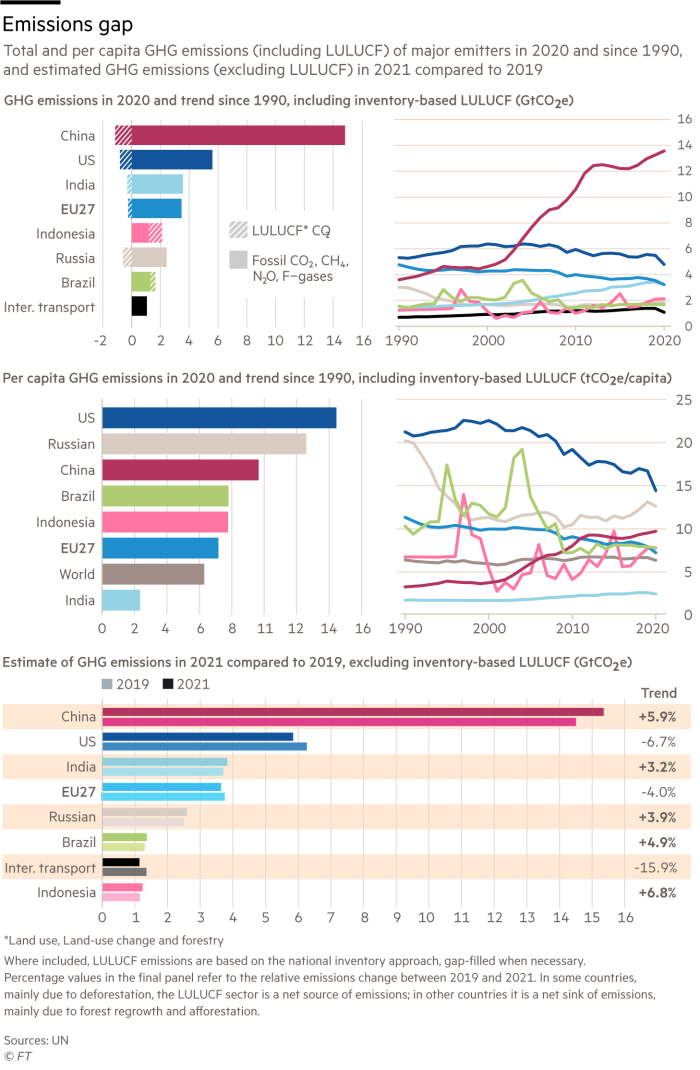World on track for up to 2.6C temperature rise by 2100, reports UN
Climate pledges made by countries worldwide are woefully inadequate and put the world on track for a temperature rise of between 2.4C and 2.6C by 2100, the leading UN environmental body has forecast, with the fatal effects of global warming already evident.
The latest analysis by the UN Environment Programme of the targets announced by 194 countries, accounting for more than 90 per cent of all greenhouse gases, said there was “no credible pathway to 1.5C in place”, referring to the Paris agreement to limit global warming. Temperatures have already risen at least 1.1C in the industrial era.
“Global and national climate commitments are falling pitifully short,” said UN secretary-general António Guterres. “We are headed for a global catastrophe. The emissions gap is a byproduct of a commitments gap. A promises gap. An action gap.”
Although countries pledged at the UN climate summit a year ago to revisit and strengthen their 2030 emissions targets by the end of this year, few have done so. They include previous laggards such as Australia and Indonesia.

While the leading emitters, the US and China, have sped up their deployment of renewable energy, their climate goals have not improved.
The updated targets announced by countries this year would shave less than 1 per cent off projected 2030 emissions — a far cry from the 45 per cent fall required to limit global warming to 1.5C, said UNEP.
Separately, the UN Framework Convention on Climate Change body that monitors Paris commitments earlier this week forecast a wider range for a rise in temperatures than its counterpart, at between 2.1C and 2.9C by 2100.
The UN reports come less than two weeks before the COP27 UN climate summit in Egypt, where global negotiators will be under pressure to make progress on how to reduce emissions and provide more in climate finance during a time of geopolitical tension and macroeconomic difficulty.
This follows a year of extreme weather events, which included devastating flooding in Pakistan and Nigeria, and unprecedented summer temperatures and droughts across much of Europe, the US and Asia.
The latest findings demonstrated “in cold scientific terms what nature has been telling us, all year, through deadly floods, storms and raging fires: we have to stop filling our atmosphere with greenhouse gases, and stop doing it fast”, said Inger Andersen, executive director of UNEP.
Global energy-related carbon emissions rebounded after the pandemic to the highest level in history in 2021 at 36.6bn tonnes, and the annual rise in methane concentrations in the atmosphere was the largest since records began, according to the World Meteorological Organization.
The International Energy Agency has projected a smaller rise in carbon emissions of 1 per cent to 33.8bn tonnes in 2022. This follows the increase in solar and wind energy, plus the take-up of electric vehicles. CO₂

Emissions forecasts for 2022 may also be affected by lower activity during lockdowns in China, the biggest contributor to global emissions, and the prospects of a recession in other developed economies.

Heat-related deaths globally have already increased by two-thirds over the past two decades, a report in medical journal The Lancet this week concluded, based on the analysis of 99 experts from organisations including the World Health Organization and led by University College London.
The UN reports also offered some solutions and chances for improvement. If countries could achieve their targets, it would give the world a 66 per cent chance of limiting warming to about 2.6C by 2100.
The UNEP said while the G20 countries were still far behind on their targets, at least 35 countries had peaked and reduced their emissions since 2019, including the US and the EU.
An urgent and systematic transformation of societies and economies would not only require behavioural change but also the adoption of new technologies and the replacement of fossil fuels with renewable energy, said the UNEP.

Governments should incentivise these changes by reforming subsidies and tax regimes, the report said, while the financial sector must also step up.
Research by BNY Mellon Investment Management and Fathom Consulting estimated this week that about $20tn of polluting assets might need to be “scrapped or retrofitted” before the end of their useful lives by 2050.
“Most financial actors, despite stated intentions, have shown limited action on climate mitigation because of short-term interests, conflicting objectives and not recognising climate risks adequately,” said the UNEP.
Climate Capital

Where climate change meets business, markets and politics. Explore the FT’s coverage here.
Are you curious about the FT’s environmental sustainability commitments? Find out more about our science-based targets here